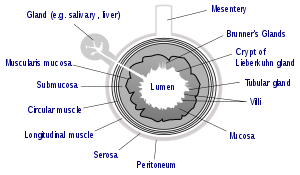What Is The Structure And Function Of The 4 Layers Of The Gi Wall?
Layers Of The Gi Tract
Keywords searched by users: What is the structure and function of the 4 layers of the GI wall 4 layers of the gi tract and their functions, layers of gi tract diagram, wall structure of gi tract organs, submucosa layer function, 4 layers of stomach wall, Mucous membrane, layers of intestine, Anatomy of gastrointestinal tract
What Are The 4 Layers Of The Git Wall?
The Git wall comprises four essential layers, each serving a distinct purpose in the digestive system. These layers are crucial for understanding the functioning of the gastrointestinal tract. Here’s an overview of the four layers:
-
Mucosa: The innermost layer of the Git wall is the mucosa. It plays a vital role in the absorption and secretion of substances during digestion. The mucosa itself consists of several sublayers, with the most superficial being the epithelium.
- 1.1.1 Epithelium: The epithelium is the surface layer of the mucosa and serves as a protective barrier while also facilitating nutrient absorption and secretion.
-
Submucosa: Located just beneath the mucosa, the submucosa contains blood vessels, nerves, and connective tissues. These components help support the mucosal layer and play a role in regulating the digestive process.
-
Muscular Layer: The muscular layer is responsible for the movement of food and substances through the gastrointestinal tract. It consists of smooth muscles that contract and relax, enabling peristalsis, a crucial process in digestion.
-
Serosa and Adventitia: The outermost layer of the Git wall varies depending on the specific part of the digestive tract. In some areas, it is referred to as serosa when covered by a serous membrane (such as the peritoneum), while in other regions, it is known as adventitia when it lacks this serous covering. These layers provide structural support and protection to the Git wall.
Understanding these four layers is essential for comprehending how the gastrointestinal system functions and how various diseases or conditions can affect its operation.
What Are The Functions Of The Different Layers Of The Intestinal Wall?
The intestinal wall is a complex structure consisting of multiple layers, each with specific functions crucial for the digestive process. One of these layers is the muscularis, which plays a vital role in facilitating peristaltic movement within the gastrointestinal (GI) tract. Peristalsis is the rhythmic contraction and relaxation of these muscles that propels food and digestive materials through the digestive system.
Beneath the muscularis lies the sub-mucosal layer, which serves to support the mucosa, the innermost layer of the intestinal wall. This support is essential for maintaining the integrity and functionality of the mucosa. The mucosa itself has distinct functions depending on its location within the GI tract. In the stomach, it forms irregular folds known as rugae, which allow the stomach to expand and accommodate varying food volumes. In the small intestine, the mucosa features finger-like protrusions called villi, which significantly increase the surface area available for the absorption of nutrients from digested food. This expanded surface area enables efficient nutrient absorption and is crucial for the body’s overall nutrient uptake and energy production.
In summary, the different layers of the intestinal wall, including the muscularis, sub-mucosal layer, and mucosa, work in concert to support various digestive functions such as peristaltic movement, structural support, and nutrient absorption, ensuring the effective processing of food within the digestive system.
What Is The Structure And Function Of The Digestive Glands?
The digestive glands play a crucial role in the digestive system by producing and delivering essential secretions. These specialized glands have ducts that transport their secretions into various parts of the digestive tract. These secretions, known as digestive juices, are rich in enzymes that facilitate the breakdown of food during digestion. Key digestive glands include the salivary glands, which release saliva in the mouth to kickstart the digestion process, gastric glands found in the stomach lining, the liver, which produces bile for emulsifying fats, the pancreas, which delivers digestive enzymes and bicarbonate into the small intestine, and the intestinal glands, which secrete additional enzymes and mucus to aid in absorption. Collectively, these glands work harmoniously to ensure the efficient digestion and absorption of nutrients within the digestive system.
Found 24 What is the structure and function of the 4 layers of the GI wall






Categories: Found 27 What Is The Structure And Function Of The 4 Layers Of The Gi Wall
See more here: c3.castu.org

All segments of the GI tract are divided into four layers: the mucosa (epithelium, lamina propria, and muscular mucosae), the submucosa, the muscularis propria (inner circular muscle layer, intermuscular space, and outer longitudinal muscle layer), and the serosa (Figure 1).Muscularis is responsible for peristaltic movement in the GI tract. Sub-mucosal layer supports the mucosa. Mucosa creates irregular folds in the stomach (rugae) and little finger-like folds in the small intestine (villi) that increase the surface area for absorption of food.Digestive glands are those having ducts that pour secretions into the digestive system. Digestive glands secrete digestive juices, which contain enzymes for the digestion of food. The digestive glands include salivary glands, gastric glands, liver, pancreas, and intestinal glands.
- 1.1 Mucosa. 1.1.1 Epithelium.
- 1.2 Submucosa.
- 1.3 Muscular layer.
- 1.4 Serosa and adventitia.
Learn more about the topic What is the structure and function of the 4 layers of the GI wall.
- Intestinal Architecture and Development – NCBI
- Gastrointestinal wall – Wikipedia
- What are the layers of the gastrointestinal tract … – BYJU’S
- What is the role of digestive glands? – BYJU’S
- What are the four layers of the alimentary canal? – BYJU’S
- The GI tract contains four layers – Oral: The Histology Guide
See more: https://c3.castu.org/category/fashion